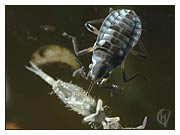THIS AMUSING LITTLE BUG ROUTS IN THE OVER GROWN BORDERS OF
DITCHES AND OTHER SMALL WATERS. Because of their small size (less than two millimeter) they are
quite unknown, in most countries they only have their Latin name. Yet they may catch the eye
because they often swarm in numbers on the surface along the borders.


a furry Microvelia


Microvelia with prey

Microvelia with Water-flea
(Spain)
The scientific name means: "(very) small Velia", so it is classified as a micro version of
the
Water cricket, a bigger bug with a much slimmer body. There are
similarities: Microvelias can also be found on small streams and they have the backwards bended
legs. Microvelia has legs which are all more or less of the same length and are moved alternating,
in that way the tiny bug is trotting amazingly fast over the water surface. You have to use a
magnifying glass to see something more of Microvelia's details. There are some species in Europe
which are difficult to recognise, they have an oval shape. Most off the time they are
wingless(
a-pterous), from time to time fully winged (
macro-pterous) specimen take
care of the colonisation of waters that are further away. When magnified they are handsome
creatures to look at, some specimen seem to have silvery fur collars. But just like
Water striders they are aggressive little hunters, that put their sharp sucking
snout in everything that's eatable. On one of the pictures on the right an unfortunate springtail
has fallen a victim to a Microvelia. They also like to prick water-fleas (especially ostracods)
that do come near the water surface. Bigger prey is sometimes encircled with Microvelias, who try
to keep other guests out by making kicking motions with their hind legs. Microvelias mate the
whole summer long and lay there eggs in rows on floating plants. The very small larvae turn become
imagos after five instars.
 back to: SURFACE BUGS
back to: SURFACE BUGS
Page track:
INDEX »
surface bugs »
Microvelia
COPYRIGHT:
All pictures on this site were made by
Gerard Visser (Aadorp,
Netherlands), unless stated otherwise. All rights remain with him. These pictures may not be
used for purposes any other than private viewing or printing. Do NOT hardlink to these pictures
or place them on other websites without the author's approval. Should you need them for purposes
which include third parties, you must ask the author permission by
e-mail. People, who want to use this pictures for exhibitions or
publications or educative material are much encouraged to do so, after approval as mentioned and
giving the normal credits.
 Dutch page
https://www.microcosmos.nl
Dutch page
https://www.microcosmos.nl









